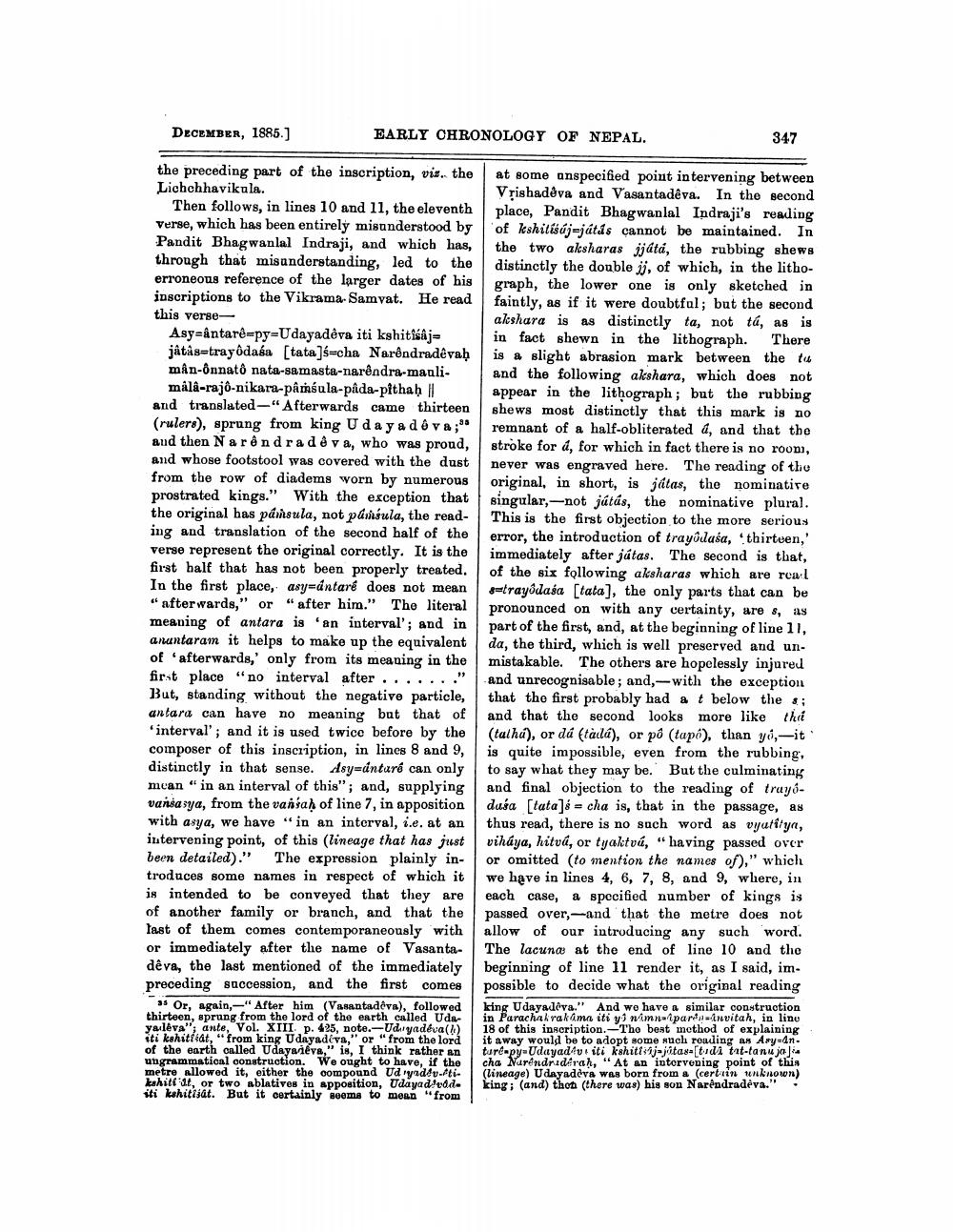________________
DECEMBER, 1885.]
EARLY CHRONOLOGY OF NEPAL.
347
the preceding part of the inscription, vis, the at some anspecified point intervening between Lichchhavikula.
Vrishadeva and Vasantadêva. In the second Then follows, in lines 10 and 11, the eleventh place, Pandit Bhagwanlal Indraji's reading Verse, which has been entirely misunderstood by of Kshitisúj=játés cannot be maintained. In Pandit Bhagwanlal Indraji, and which has, the two aksharas jjátá, the rubbing shews through that misunderstanding, led to the distinctly the double jj, of which, in the lithoerroneous reference of the larger dates of his graph, the lower one is only sketched in inscriptions to the Vikrama-Samvat. He read faintly, as if it were doubtful; but the second this verse
akshara is as distinctly ta, not tá, as is Asy-antarémpy-Udayadeva iti kshitiśáj- in fact shewn in the lithograph. There játás-tray Odasa (tata]swcha Narendradêvah is a slight abrasion mark between the tu mân-Ônnatô nata-samasta-narendra-mauli- and the following akshara, which does not
mála-rajô-nikara-pânsula-pada-pithah || appear in the lithograph; but the rubbing and translated "Afterwards came thirteen shews most distinctly that this mark is no (rulers), sprung from king Udaya d va ;** remnant of a half-obliterated 4, and that the and then Narendra d d v a, who was proud, stroke for d, for which in fact there is no room, and whose footstool was covered with the dust never was engraved here. The reading of thu from the row of diadems worn by numerous original, in short, is játas, the nominative prostrated kings." With the exception that singular,--not játás, the nominative plural. the original has páinsula, not pasula, the read- This is the first objection to the more serious ing and translation of the second half of the error, the introduction of trayódusa, thirteen,' verse represent the original correctly. It is the immediately after játas. The second is that, first half that has not been properly treated. of the six following aksharas which are real In the first place, asyrantaré does not mean satrayodasa (tata], the only parts that can be "afterwards," or "after him." The literal pronounced on with any certainty, are 8, 128 meaning of antara is an interval'; and in part of the first, and, at the beginning of line 11, anuntaram it helps to make up the equivalent da, the third, which is well preserved and unof afterwards,' only from its meaning in the mistakable. The others are hopelessly injured first place "no interval after ......." and unrecognisable; and, with the exception But, standing without the negative particle, that the first probably had a t below the si antara can have no meaning but that of and that the second looks more like thii 'interval'; and it is used twice before by the talha), or dá (taula), or pô (tapó), than yo-it composer of this inscription, in lines 8 and 9, is quite impossible, even from the rubbing, distinctly in that sense. Asyrantaré can only to say what they may be. But the culminating mcan "in an interval of this"; and, supplying and final objection to the reading of truyóvansasya, from the vanjah of line 7, in apposition dusa (tata]ó = cha is, that in the passage, as with asya, we have "in an interval, i.e. at anthus read, there is no such word as vyutilya, intervening point, of this (lineage that has just | viháya, hitvá, or tyaktvé, "having passed over been detailed)." The expression plainly in- or omitted (to mention the names of)," which troduces some names in respect of which it we have in lines 4, 6, 7, 8, and 9, where, in is intended to be conveyed that they are each case, a specified number of kings is of another family or branch, and that the passed over,--and that the metre does not last of them comes contemporaneously with allow of our introducing any such word. or immediately after the name of Vasanta- The lacuna at the end of line 10 and the deva, the last mentioned of the immediately beginning of line 1l render it, as I said, im. preceding succession, and the first comes | possible to decide what the original reading
38 Or, again," After him (Vasantadêva), followed king Udayadeva." And we have a similar construction thirteen, sprung from the lord of the earth called Uds. in Parachak rakama iti yi wimpartasinvitah, in line ya leva"; ante, Vol. XIII p. 485, noto.-Udiyadeva(b) 18 of this inscription. -Tho beat method of explaining iti kahitféat," from king Udayadiva," or "from the lord | it away would be to adopt some such reading an Arydn. of the earth onlled Udayaiéva," is, I think rather an turlapy-Udayad utiti kahit sijajitasutud tat-tanu ja ungrammatical construction. We ought to have, if the cha Nurendridérah, "At an intervening point of this metre allowed it, either the compound Udyadau.lti- (lineage) Udayadeva was born from a certain wnknown) kahittat, or two ablatives in apposition, Udayad/vod- king ; (and) thot (there was) his son Narendradeva." iti kshitisat. But it certainly seems to mean from




